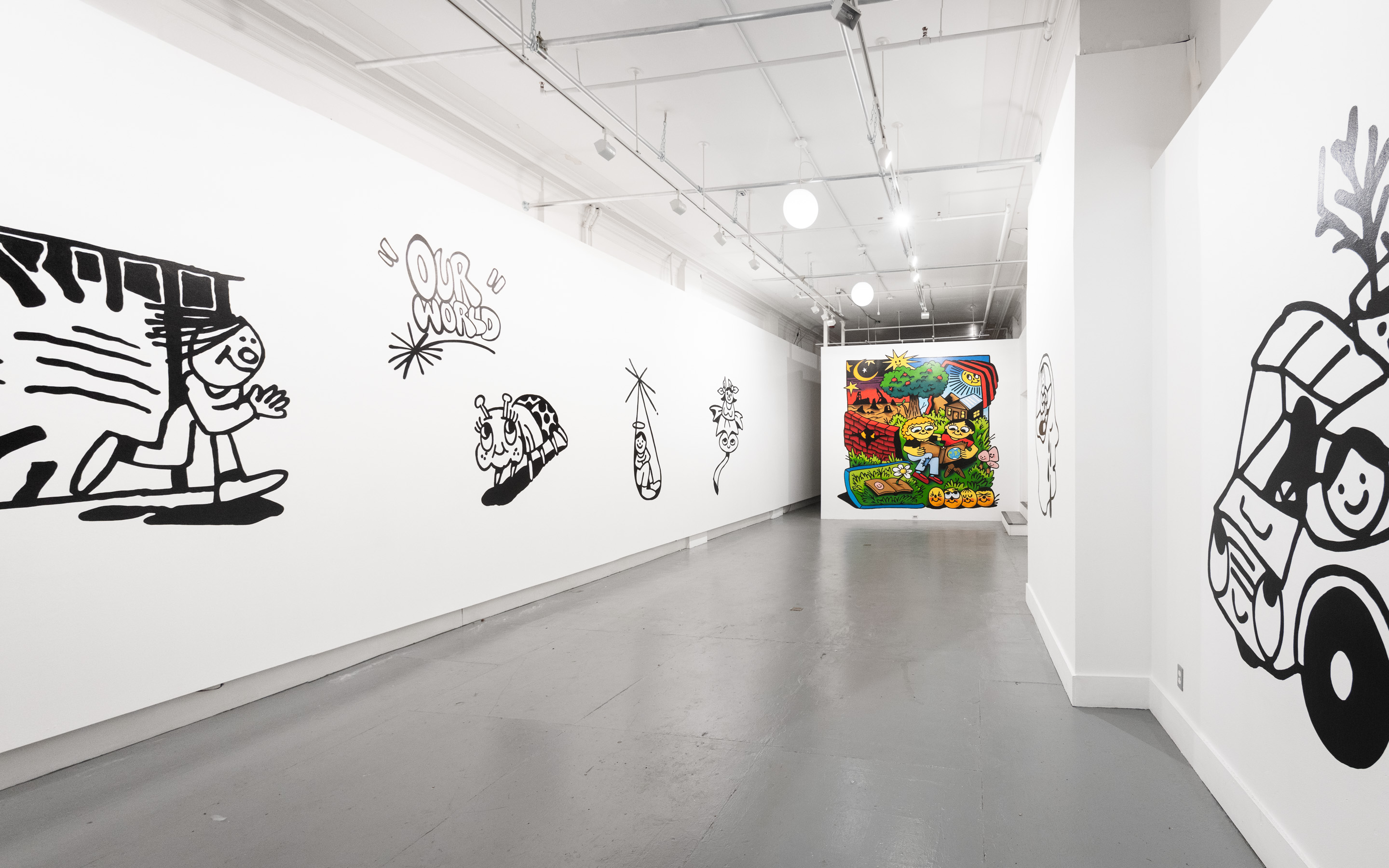I spoke with Bee Daniel on October 7th, the week after Our World debuted at the 2019 New England Art Book Fair. We sat in the gallery at SPACE and talked through the symbolism within their imagery, the formal influences of 60s and 70s children’s book illustrators, trans representation in visual culture, and doodling as an art form and survival method.
Can you share some background on the title Our World? How did this come about? Who is “Our”?
We are “Our”- all things. I think there is an idea of people compartmentalizing the world into different categories. Often times there are categories to acknowledge, but we are all one; Not just a human world, but the plant world, the bug world, the animal world, the spiritual world.
It is not even just the physical world. There are so many layers and ways in which things exist.
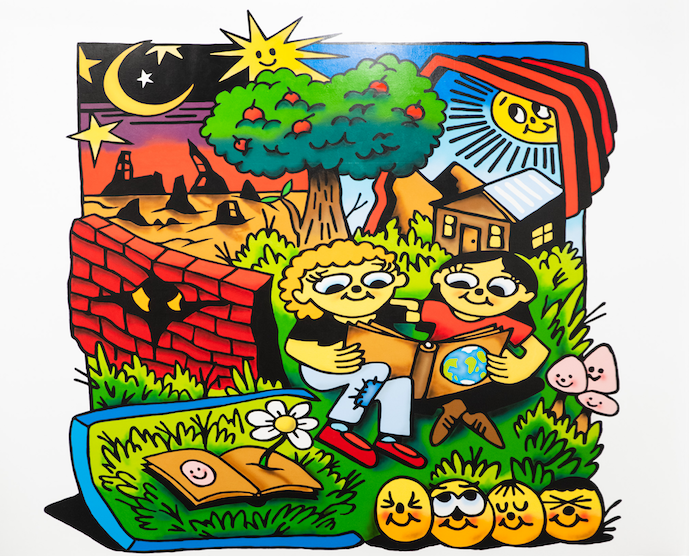
In your artist statement you list both utopia and dystopia as subject matter you mine. Can you talk more about how that dichotomy weaves through your practice? In the large color mural of Our World, there is some haunting and bleak imagery interwoven within an otherwise idyllic scene.
They are both always there, it’s part of being alive. Our World has to have both. It is devastatingly beautiful in every way. You can’t have one without the other. The main color mural acknowledges that reality but I hope also explores a sense of how people come together and be open. How can they interact and give each other things and prosper? How do you step outside of yourself and come to a place of caring for people who are more marginalized and those who face bigger hardships?
So your vision is optimistic?
Yes, but you have to have some kind of pessimistic, or realistic outlook. You can’t deny what is going on. And you can’t come to a better place for yourself or with others without going through inner turmoil, hard realizations, life changing experiences.
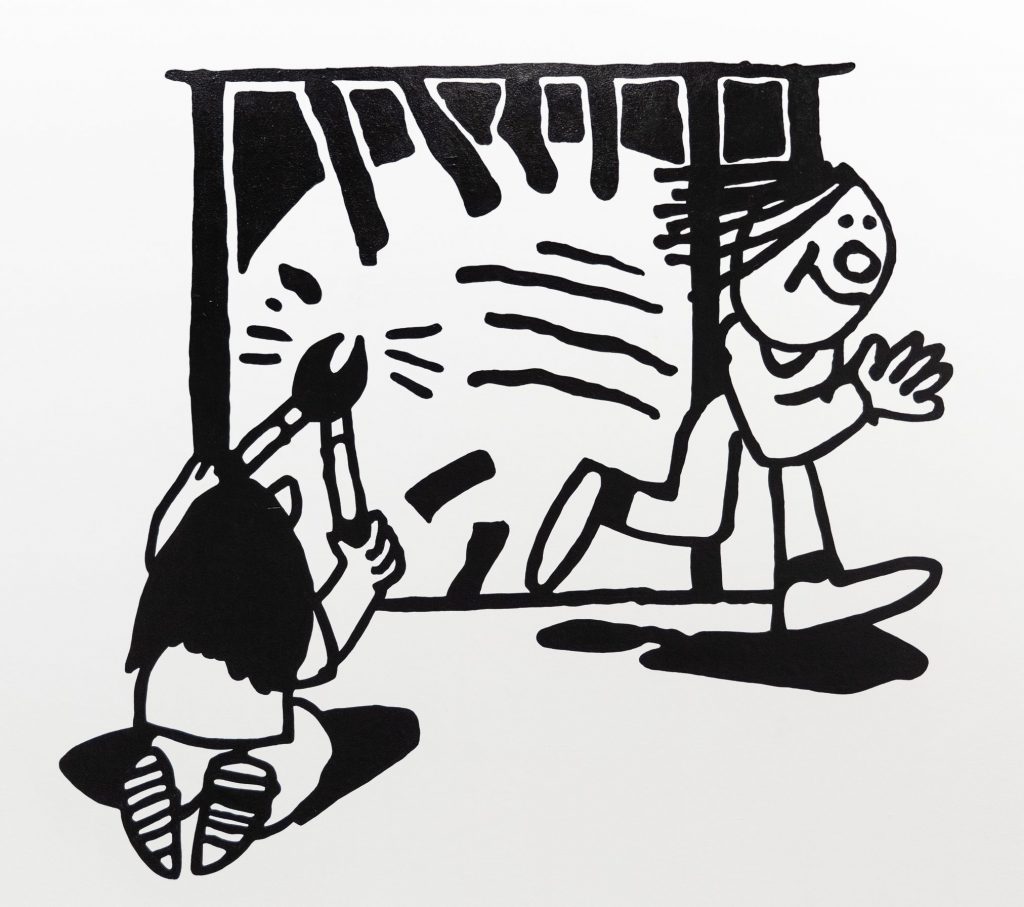
The first black and white image on the left wall has one figure using bolt cutters on a fence and freeing another figure who was trapped. It holds a kind of freedom narrative, one loaded with present-day associations. How do you think about what it signifies?
It could be anything. Literally one person freeing another using bolt cutters they stole. Or finding freedom at borders that are arbitrarily enforced. It could be the same person and they are freeing themselves. Freeing yourself from whatever cage you put yourself in. I think it speaks to internal blocks and traps as well. So many people feel like they can’t do certain things.
I wanted it to have some openness for whatever was coming up for anyone, but it does speak to our current political landscape and the lack of care for life and the outrage expressed by many. There are other times when I have made work that is very pointedly political, when something specific really needs to be said. But this is more expansive than that.
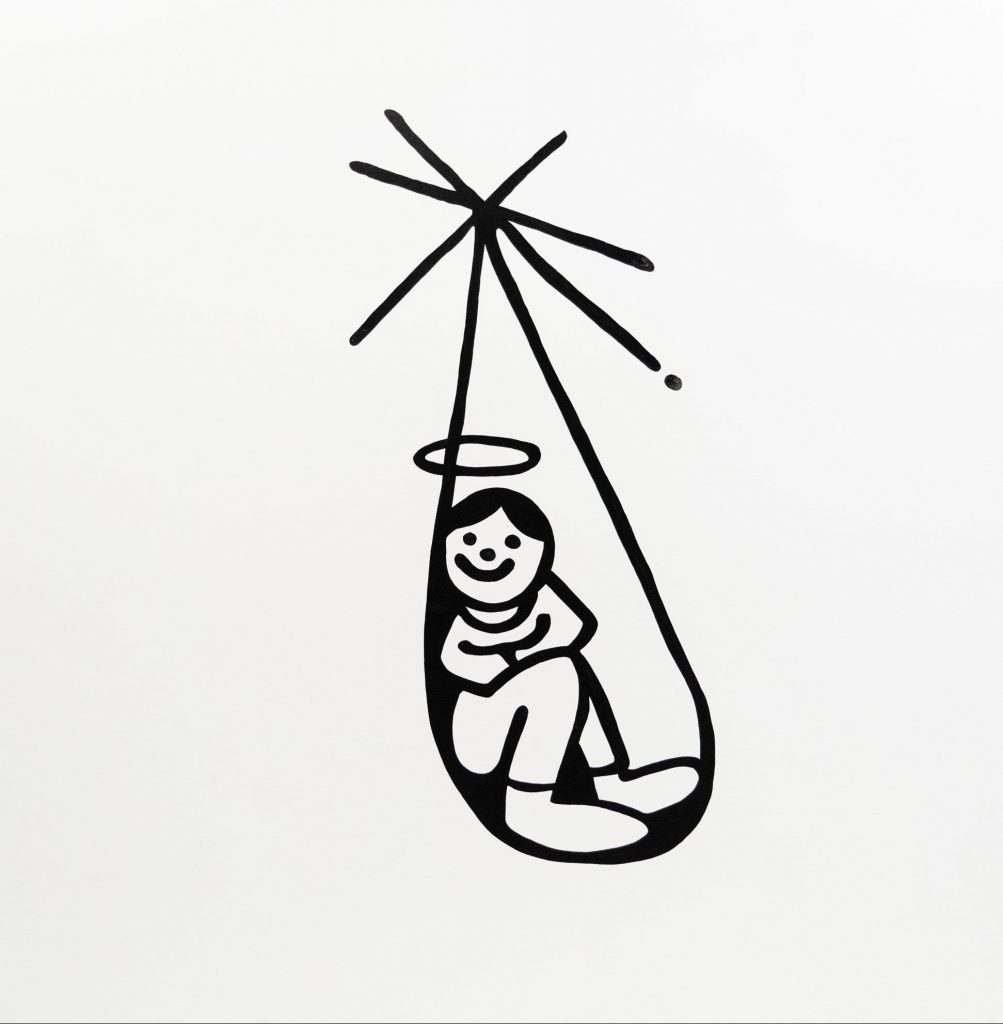
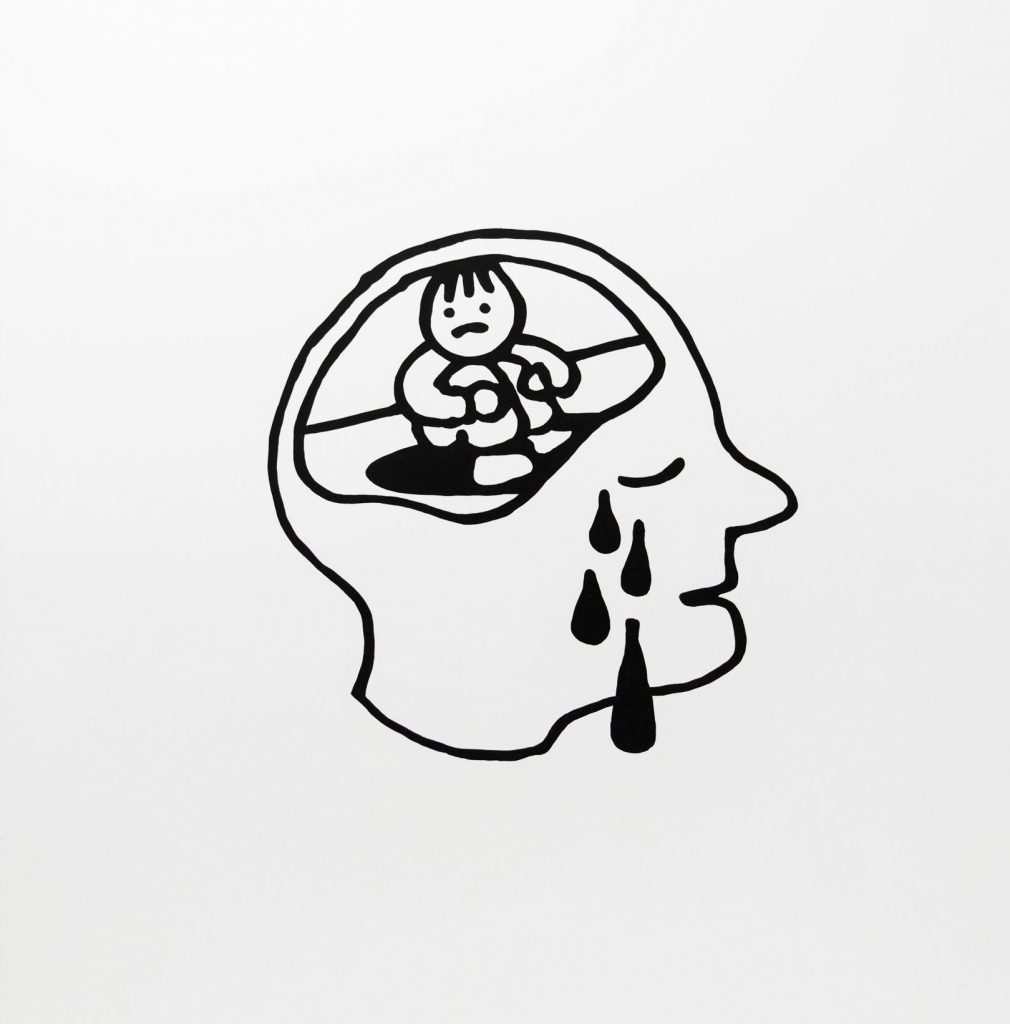
The figure with the halo- tell me more about that.
I see it as a symbol for genuine goodness or holiness- here with a singular figure. Holiness doesn’t need to be associated with religion. Everyone is holy in their own right no matter their belief. I chose that to be opposite from the image on the other wall, of someone crying inside their own head. Being alone can be both things. We have all had such beautiful moments where you are so blissed out and you are alone, and you are in a field and its golden hour and it’s the perfect temperature and everything is where it is and you are where you are. You are in yourself and its holy. Then the opposite, being alone and being totally stuck in your head. You can be in the void in both ways. You can be in bliss or hell.
I can trace that to the beginning of how my entire “style” started. From drawing smiley faces because I was so fucking depressed. No job, no place to live, broke as fuck for so long, literally sitting in a park for hours and just drawing things that make me happy and make me laugh. That is part of that image on the right. Being so deeply in your head and working through it, but still not sure how to get out of that space.
Do you see this exhibition as an elevation of your doodling practice?
Yes. Doodling is so important. It’s a fixation- when you are nervous or excited or bored. It does reveal your preoccupations.
I mean, all of these black and white images are just my sharpie drawings painted on a wall. I can work in a very tight way for murals, but with these I tried to still maintain that loose line work. I draw with a sharpie a lot. I keep different books for different things and I have many sharpie books. Obviously with a pen or marker you can’t erase so you are forced to learn to work with the imperfections. I think they show your hand in the drawing.
Who are some of your influences? Do you draw inspiration from the realms of illustration or graphic novels?
I don’t look at a lot of contemporary, capital A art, or illustration. I look at other things. I look at tattoos a lot, clothing people make, graffiti and my friends artwork. Psychedelic imagery.
This project in particular draws influence from 60s and 70s children’s books. I do the Goodwill buy the pound thing a lot. That is such a good spot for me. That Ed Emberly book, Big Orange Drawing Book. Also Handling Your Ups and Downs by Joy Wilt, Ernie Hergenroeder did the illustrations. Certainly Richard Scarry. Old illustrators like that I really love. And it isn’t even their specific content, but the looseness. How loose and simple the lines and forms can be. I find so much beauty in the ways people worked in that time period, which is very different from a lot of illustration now — super produced, complex, and technological. So many of those drawings are just two or three colors filled in, and still spilling over the outline.
Do you notice in drawing from children’s books that you are revisiting your childhood in a way? There are themes of youth in all of this.
Yes. Youth is the most important part of life. So formative. You learn so many things in such a small amount of time and everything affects you for the rest of your life.
You identify in your artist statement as a non binary trans artist. Do you think of your work as directly exploring trans identity?
I do explore it. I strive to not put genders on the figures I make. I care about that representation.
That is deeply different from the source imagery you draw from.
Totally. They are super dated in how they represent gender, how they do or don’t represent Trans people, Black people, Indigenous people, and POC. I try to draw from my own experience and my own life. I am gay, I am trans. I spend much of my time around queer people, so its just the way of it. I draw my friends a lot and actual events or situations that I experience with them. I remember 6 or 7 years ago I painted a mural of some teenage figures hanging out. Two characters were more femme presenting in their clothing but they were pretty muscular and buff. There were some people who came by and looked at the wall and seemed disgusted and weirded out by that, and commented “Why don’t you make these girls hot?” It really tripped me out. I was like, ok, I am going to go completely in the other direction. I don’t want my characters to be gendered. I started putting more focus on anthropomorphizing things- like a book, or a house, or a mushroom. What is gender anyways? What does it mean to be alive and have a body? Whoever’s body it is should do with it what they like and it’s not for anyone else but themselves.
Talking through it helps me a lot. I guess I am reclaiming some styles that speak to me, but wanting representation equitable within it. As a way of telling stories for everyone.
It makes me think of the relatively new visibility of trans artists in the capital A art world. Artists like Julianna Huxtable or Zachary Drucker and Rhys Ernst being shown in The New Museum or The Whitney. Their artistry in documenting their specific trans journey or depicting a trans body is also this staggering reckoning with art history. You confront the deep limitations of how visual culture has defined who gets to be beautiful. Who gets to have their portrait taken. Who gets to be an odalisque.
It seems like it’s been decided for some time that beautiful is only a space held by thin, white, cisgendered bodies. In my opinion this is the furthest thing from the truth! I think it’s fucking awesome that people are at the forefront and reckoning with representation. But also the art world is hard and I am scared of it. I don’t like it. I am really cautious with it. How quickly something can become tokenized or people become a fetish object. I think working to deconstruct what art is as a whole and the world it lives in and who profits off it is too important and I feel like we are in a crucial moment with that happening.
I think a lot about art on the internet and art on instagram. There is a whole generation of folks who are BIPOC, queer, or trans who don’t have a studio, work out of their bedroom or a coffee shop, and are amazing artists. They don’t have to access the “art world” to get exposure and maybe don’t even want it. The internet provides a whole other way to show who you are- people’s identity and their art all on display. That is really cool, but has its own pitfalls too. I try to show who I am on the internet and be real about who is making this work but still recognize that I am a thin white person and that that alone can dictate how people view my work. My voice is valid but I am cautious of how much space I take up. I would rather have my work take the front seat and if people like it that’s great.
For me, when I was young, I would go to some gallery openings and museums and feel so detached and unsure of who the artist was. I was always asking, who is this? Who did this? It felt really inaccessible and frustrating. I stopped going to these spaces and events and wanted to be involved in places where I felt represented or places where there was no hierarchy, homophobia, classism, sexism, racism or tokenization or even entry fee. This was how New Fruit started, by a group of people feeling frustrated by white walled galleries. We wanted to provide space for anyone to show work or make work regardless of their ability or history with art making. This started in our basement in the winter of 2014 and is now a collectively run studio space and houses an affordable community print shop called Perm Press inside of it.
Anything else you want to share about Our World?
I am just tripping on all of this because it is so new. I have worked on a lot of big projects in the past, but many of them have been other people’s projects. This is the first time I have been asked by a place, by an organization, to do something and have them give me so much creative license; saying, do what you want to do. It is so beautiful, and so freeing. I want to extend that out- I want people to come in here and hang out. People can touch the walls. You can sit down and draw and breathe and chill.
Big thanks to all my friends who helped with this: Rachel Previle, Pete Swegart, Kelly Rioux, Arthur Katrina, everyone at New Fruit and everyone at SPACE.

